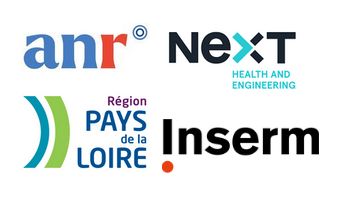Innovative approaches in ion channel biology
Investigators: Michel De Waard, Gildas Loussouarn, Jérôme Montnach, Barbara Ribeiro
PhD students: Alina Akisheva, Oliver Brun, Leos Cmarko, Matthias Dereli, Hugo Millet, Mathilde Poulet
Support staff: Floriane Bibault, Agnès Hivonnait, Béatrice Ollivier, Pauline Tesson
Ion channels are key targets in cardiac disorders as well as in muscular or neurological pathologies. Although therapeutic solutions exist to manage cardiac arrhythmias, clinicians suffered from lack of innovative therapies for non-responsive patients. In addition, the mechanisms linking mutations in ion channels to pathologic phenotype are not well known due to the lack of selective compounds. Innovative pharmacological approaches targeting ion channels are crucial to decipher arrhythmogenic mechanisms and to propose new therapies for the clinic.
To this purpose, we reinforced the molecular screening axis by continuing to use the libraries of peptides from venoms, but also by implementing libraries from marine unicellular algua or from plant extracts or small compounds identified by Artifical Intelligence. We are screening compounds on multiple cardiac ion channels thanks to our large portofolio of stable cell lines expressing those ion channels. This allows us to identify pharmacological drugs able to produce arrhythmias by themselves (pharmacological models of arrhythmias) or to correct arrhythmias associated with channelopathies.
In addition, aiming to identify ion channels to target in cardiac arrhythmias, we reinforced the engineered peptides axis to develop biologically active peptides. Our screening campaigns allow us to diversify the pharmacological arsenal available to control ion channel activity, both in terms of activation and inhibition. However, these tools may lack some interesting chemical properties that we could be engineered at our level. We have done the proof of concept that high affinity (<50 nM) and slow Koff peptides (> 10 min), engineered to harbor a fluorescent tag can be used to specifically label ion channels expressed at the sarcoplasmic membrane but also in the intracellular compartments as the endoplasmic reticulum. We will continue to diversify our portfolio of fluorescent peptides to replace advantageously antibodies. We also engineered peptides to photocontrol their activity in order to possess temporal and spatial control over channel activation or inhibition. We aim to develop photosensitive peptides using photolabile protecting groups on important amino acids of the pharmacophore or azobenzene-modified peptides to modulate in channels activities from in vitro (re-expression models, cardiomyocytes derived from human iPS) to in vivo (anesthetized rats and mice) through ex vivo (isolated heart, brain slices). In addition, with the objective to design smaller compounds with better pharmacokinetics and availability for clinical applications (peptides are poorly-performing compounds for oral administration), we engineer natural peptide ligands containing a photoaffinity-labelling moiety that allows for irreversible covalent coupling of the ligand to the ion-channel-binding site. Using this strategy along with biochemical purification and MS/MS analyses of the channel/peptide complex we should be able to define with precision the binding site of our newly discovered peptide ligands.
As pharmacological innovative tools have a tremendous interest to modulate ion channels in a spatially defined approach on cardiac tissue and assess the importance of channel distribution in cardiac excitability, we initiated the cardiac photopharmacology axis to better understand arrhythmogenic mechanisms and propose innovative treatments. We investigated consequences of local modulation of ion channel activity in order to define arrhythmogenic regions and investigated the used of photoactivatable peptides to terminate or prevent arrhythmias. With a preclinical focus, we investigated the use of wireless implantable devices for in vivo cardiac photopharmacology in order to activate precisely photosensitive peptides in arrhythmogenic vigil animals.
In addition aiming to better understand implications of ion channels defects on cardiac activity, we have developed, thanks to the high-throughput patch-clamp setup, a genetic variant screening axis by investigating biophysical consequences of more than 300 French missense variants in KCNH2 gene with uncertain clinical significance in order to reclassify these variants based on a robust functional score. We assembled a consortium of clinicians, geneticists, biophysicists and computer bioscientists to build the largest web-accessible diagnostic/prognostic database of hERG-related channelopathies.
Learn more about our projects:
- ANR JCJC WOCAR : Jerome Montnach (2023-2027)
- ANR TRITMD : Michel De Waard (2023-2026)
- ANR Nav1.2 RESCUE : Michel De Waard (2022-2025)
- ERA-NET ICMI : Michel De Waard (2021-2025)
Fluorescent- and tagged-protoxin II peptides: potent markers of the Nav 1.7 channel pain target. Montnach J, De Waard S, Nicolas S, Burel S, Osorio N, Zoukimian C, Mantegazza M, Boukaiba R, Béroud R, Partiseti M, Delmas P, Marionneau C, De Waard M. Br J Pharmacol. 2021;178:2632-2650. doi: 10.1111/bph.15453.
A standardised hERG phenotyping pipeline to evaluate KCNH2 genetic variant pathogenicity. Oliveira-Mendes B, Feliciangeli S, Ménard M, Chatelain F, Alameh M, Montnach J, Nicolas S, Ollivier B, Barc J, Baró I, Schott JJ, Probst V, Kyndt F, Denjoy I, Lesage F, Loussouarn G, De Waard M. Clin Transl Med. 2021 Nov;11(11):e609. doi: 10.1002/ctm2.609. PMID: 34841674
Modelling sudden cardiac death risks factors in patients with coronavirus disease of 2019: the hydroxychloroquine and azithromycin case. Montnach J, Baró I, Charpentier F, De Waard M, Loussouarn G. Europace. 2021 Jul 18;23(7):1124-1133. doi: 10.1093/europace/euab043. PMID: 34009333
Computer modeling of whole-cell voltage-clamp analyses to delineate guidelines for good practice of manual and automated patch-clamp. Montnach J, Lorenzini M, Lesage A, Simon I, Nicolas S, Moreau E, Marionneau C, Baró I, De Waard M, Loussouarn G. Sci Rep. 2021 Feb 8;11(1):3282. doi: 10.1038/s41598-021-82077-8. PMID: 33558601 Free PMC article.
Functional Impact of BeKm-1, a High-Affinity hERG Blocker, on Cardiomyocytes Derived from Human-Induced Pluripotent Stem Cells. De Waard S, Montnach J, Ribeiro B, Nicolas S, Forest V, Charpentier F, Mangoni ME, Gaborit N, Ronjat M, Loussouarn G, Lemarchand P, De Waard M. Int J Mol Sci. 2020;21:7167. doi: 10.3390/ijms21197167.
Funding
- Agence Nationale de la Recherche
- Inserm
- NExT
- Région Pays de la Loire






